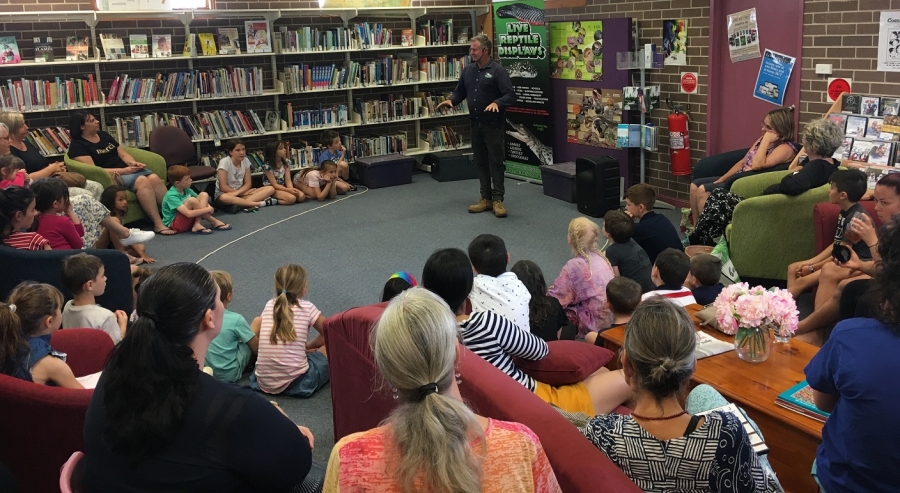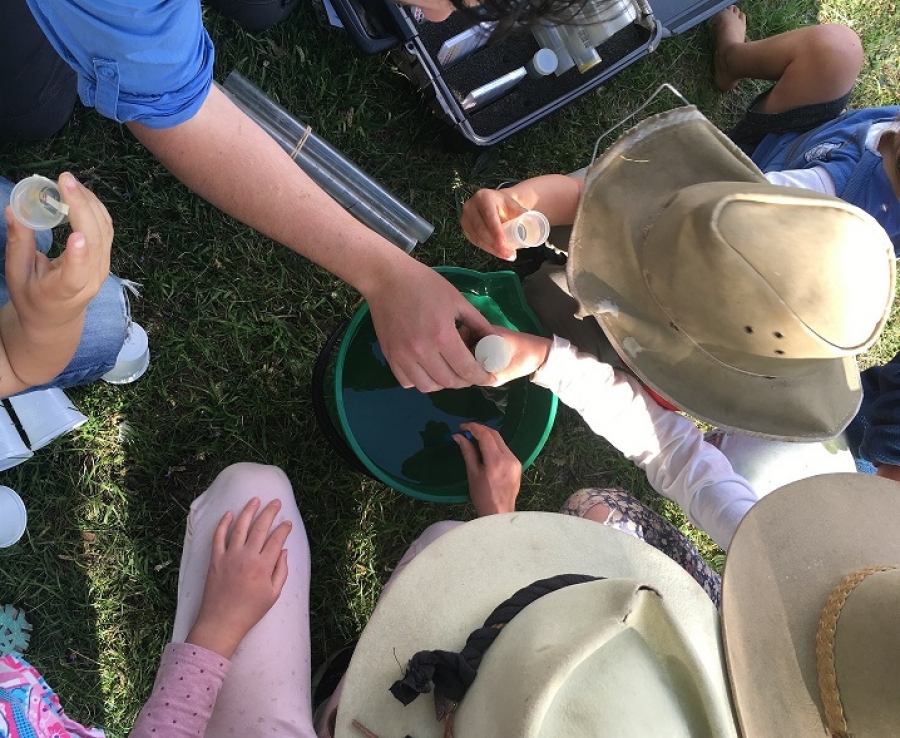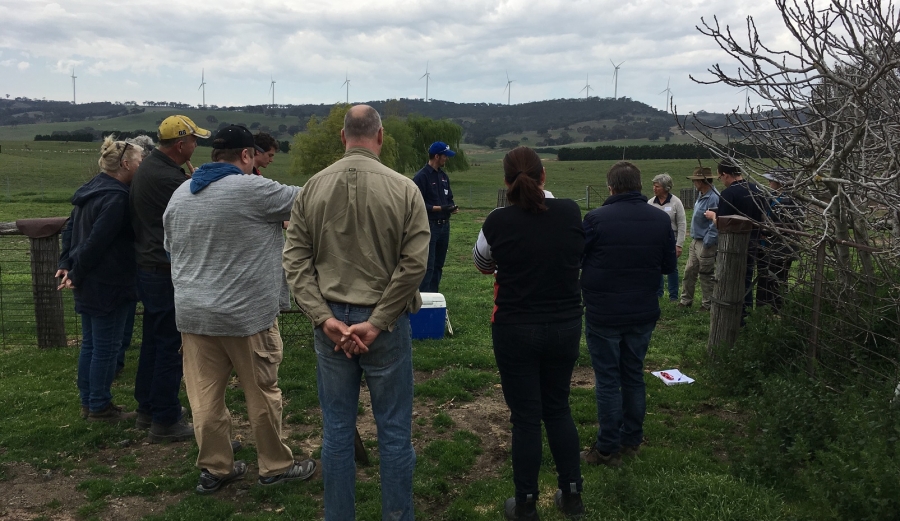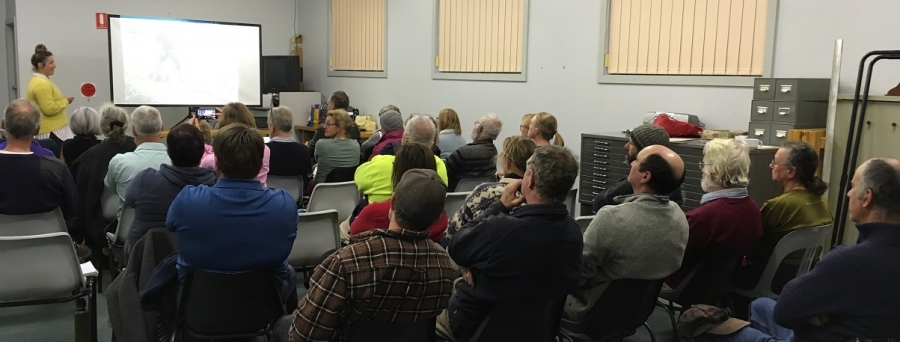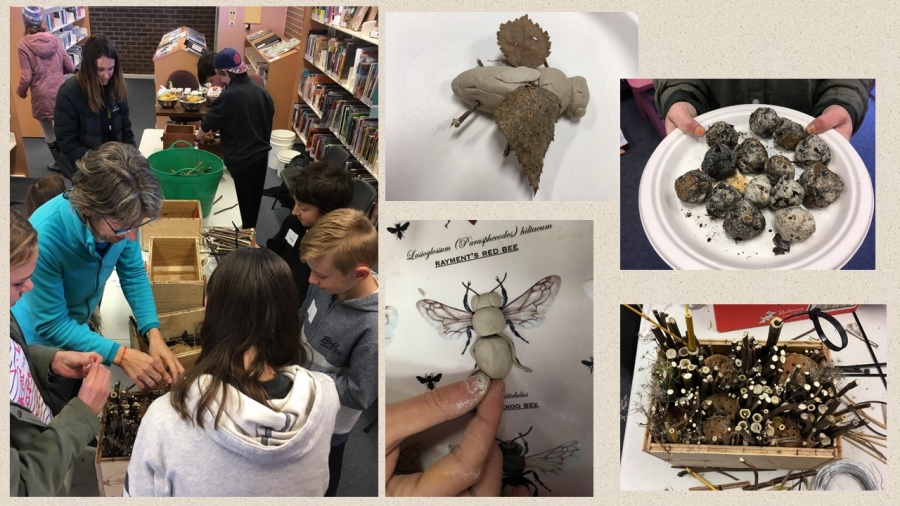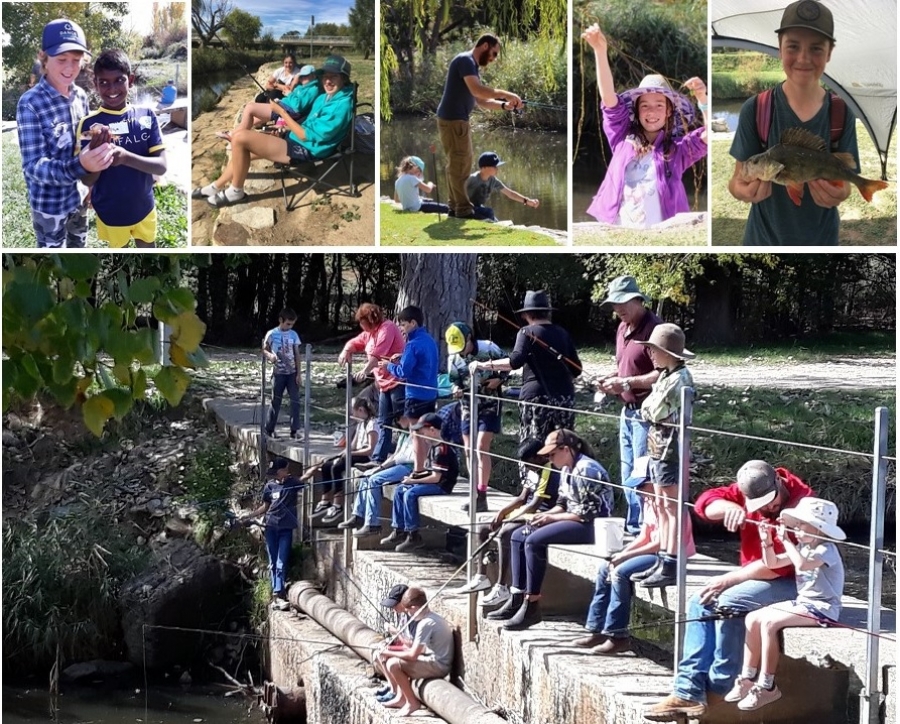Close up with local reptiles
Thanks to everyone who came along to Gunning District Landcare's reptile school holiday activity in mid January. The Upper Lachlan Shire Council Gunning Library was packed with enthusiastic children and parents/grandparents/carers. Andrew Melrose from Live Reptile Displays.com.au told us some great stories about reptiles. We learnt that Shingle Backs pair for life, and why some people call them 'Bog Eye Lizards'. We were also told how reptiles help to control pests, and how we can look after them, by looking after their habitat and not hurting or killing them. Everyone got to feel the skin of some wonderful species that occur locally - Blue Tongue and Blotched Blue Tongue, Shingle Back, Bearded Dragon (which one girl had sitting on her head!), Water Dragon. We also got to touch a baby saltwater croc and carpet snake from further afield. The turtles and goanna were other favourites. Many thanks to Bianca, Janet and Deb for helping out on the day!
Gunning District Landcare – Winner of NSW Fish Habitat Award!!!
Gunning District Landcare was announced the winner of the 2019 BCF ‘Give Back to Fish Habitat Award’ at the NSW Landcare and Local Land Services Conference in Broken Hill on 23rd October. Sonya Duus and Gillian Malcolm were at the event to receive the award on behalf of the group.
Gunning District Landcare received the award in recognition of its significant and on-going work to care for the endangered Southern Pygmy Perch in the Gunning region. In 2017, Gunning District Landcare commissioned Associate Professor Mark Lintermans (who originally found the species in the Gunning district in 2002) and Mr Luke Pearce from NSW Fisheries, to develop a Local Action Plan for Southern Pygmy Perch. The Action Plan lays out recommended actions to conserve the species and guides the Landcare group’s activities.
Janet Heffernan has been a particularly active advocate for Southern Pygmy Perch within Gunning District Landcare. She has been the driving force behind activities such as teaching landholders how to establish aquatic plants in farm dams, as part of the refuge dam project for the endangered fish.
Associate Professor Mark Lintermans recently commented that he would like to see other Landcare groups following in the footsteps of the Gunning group, saying “This is a tough time for native fish that live in small streams. The on-going drought really hits them hard, as waterways dry up. Terrestrial environments obviously need attention, but these aquatic species are too often completely overlooked. They desperately need our help.”
Gunning District Landcare is now actively looking for funds to train local community members to monitor the species in local waterways, and to send some Southern Pygmy Perch to a special breeding facility to help build up their numbers.
Gunning District Landcare is deeply grateful to Ruth Aveyard from Upper Lachlan Landcare who nominated the group for the award.
The Importance of Maintaining Groundcover
The final presenter in our 2019 series of evening seminars was Paul Hewitt, a sheep grazier from Grabben Gullen and co-facilitator of the Upper Lachlan Grazing Group. Paul spoke about the importance of maintaining groundcover and balanced decision making in grazing systems. He led us through a thoroughly engaging and thought-provoking slide show of concepts and examples. He advocated that land managers should be aiming to: retain groundcover; match stock numbers to the conditions; increase the diversity of plants and organisms; protect and improve soil health; regularly monitor farming practices and modify as necessary; and consider environmental, economic and emotional outcomes. Paul showed photos from his own property, which were testament to the effectiveness of his approach.
'Healthy Waterways' School Holiday Activity
On a lovely spring day in October 2019, we had Alex James from the Molonglo Conservation Group run a Waterwatch activity for children in Crookwell and Gunning. In Gunning, we started at the library where we discussed the elements that make up healthy waterways, and where Alex showed us a stuffed platypus and rakali (native water rat)! Then we headed off to Barbour Park where the children collected water samples and water life from Meadow Creek. Then everyone was heads-down, fishing out the various weird and wonderful waterbugs from the samples trays. The children were amazed how many bugs we had collected and the diversity of these creatures, from what looked to be a fairly lifeless stretch of shallow water. One of the more unusual waterbugs found on the day was a 'Messy Stick Caddis'. Alex also got out his science kit so the children could measure the turbidity, pH, and EC (electrical conductivity) of Meadow Creek. Great fun was had by all.
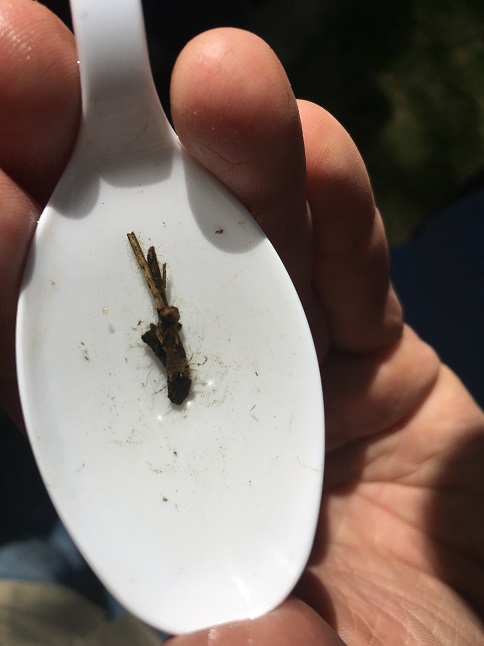
Messy Stick Caddis, found by children in Meadow Creek
Baits and Trail Camera Workshop
Gunning District Landcare has been a central player in establishing the region's coordinated fox baiting program. While the program is largely successful, there are always improvements that can be made, such as ensuring best practice baiting techniques are followed, and improving monitoring of pest animals and the impact of the baiting program. Thanks to funds from the Managing Established Pest Animal And Weeds program (MEPAAW - a partnership between NSW DPI and Landcare NSW), we were able to offer a workshop on 'Laying Baits & Using Trail Cameras'. The aims of the workshop were: 1) provide some practical demonstration of the best methods for laying baits and choosing the best baiting sites, and 2) demonstrate how to effectively use trail cameras to monitor and manage pest animals. Bobby Dillon, a bio-security officer from the Goulburn Local Land Services office, conducted the workshop which was held on a farm close to Gunning. The workshop started with an informative powerpoint presentation in the shearing shed, before we moved outside to watch a demonstration of tethering baits, setting Canid Pest Ejectors, and discussing the best locations for laying baits (TIP: "think like a fox"!). The workshop finished inside where participants were entranced by trail camera photos of pests and wildlife. We then enjoyed some long chats over a lovely catered lunch. The workshop was informative and enjoyable, and all participants were clearly engaged. New baiters left feeling more confident about how to get started, and experienced baiters picked up some good tips and tricks to make their practices more effective. There was some unexpected advice, such as the garnishing baits with blackberry jam, and splashing fish sauce or tuna oil around the baiting location. It seemed that everyone was inspired to try using trail cameras to get a better understanding of the pests and wildlife on their properies.

Combining Production & Biodiversity
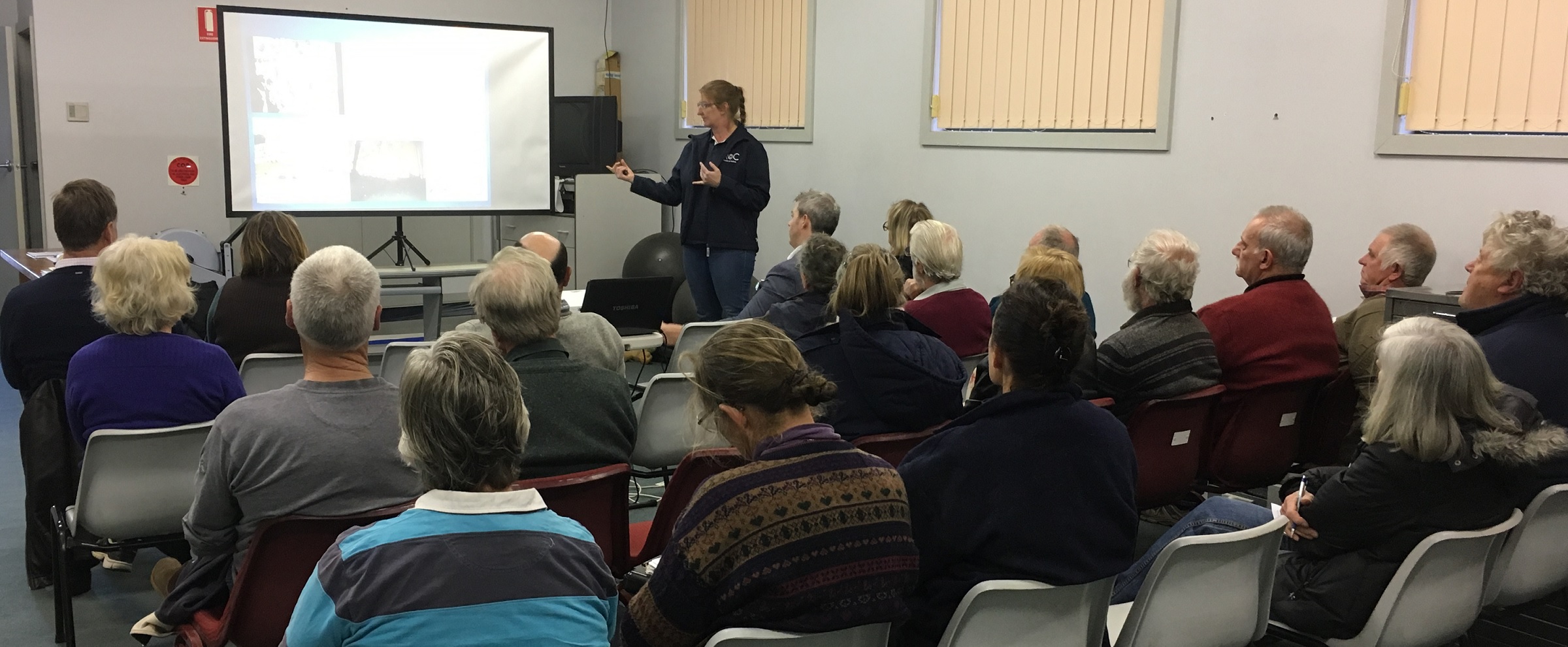
In the second of Gunning District Landcare's 'Spring Series' seminars for 2019, we were treated to two passionate presentations about biodiversity on farms. Lori Gould, of Grassroots Consulting, addressed the ‘why’ of looking after biodiversity, reminding us of the importance of ecological connections on our farms and properties. She also demonstrated how easy it can be to plan biodiversity planting with some simple principles in mind, demonstrating on a map she pulled out from SIX maps (which is freely available for anyone).
Debra Butt then had us captivated with the story of how her family manages their farm, including the decision to fence off a large portion of their property as part of the Picaree Hill Conservation Project. The Project was a joint initiative involving local landholders, Murrumbateman Landcare Group, and Greening Australia. It also built on previous projects with the result that there is now 54km of habitat corridors spanning numerous properties! Debra also explained how her family makes everyday farm management decisions with the objective (and result) of maintaining groundcover at all times. This was fascinating to everyone in the room, and is a topic that will be further explored at our next seminar on 14th October.
Understanding Soils For Better Land Management
The first of Gunning District Landcare's 'Spring Series' seminars for 2019 drew a large crowd to learn about how to get to know our soils, and how to apply this knowledge in land management decisions. The presenter, Katharine Brown, has a wealth of knowledge and a passion for teaching land managers how to understand their soils in more depth - and encouraged everyone to test their soils at depth! Katharine mentioned some valuable free resources and will be sharing still more in time. For now, it is well worth checking out these links:
Northern Rivers Soil Health Card: A soil management tool developed by farmers for farmers.The soil health card lists 10 straightforward visual soil tests that require simple equipment and can be carried out by one person in the field. It provides space for you to rate your own soils after carrying out the tests. By testing regularly and keeping the cards, you can build up a record of your soil health, and understand the effect of management practices on soil health.
eSpade: eSPADE is a Google Maps-based information system that allows easy, no-cost, map-based access to a wealth of soil and land information from across NSW. The data accessible through eSPADE is sourced mainly from the NSW Soil and Land Information System (SALIS).
SoilMapp for iPad: Find out what's beneath your feet with SoilMapp which taps into the best available soil information from Australia's national soil databases. You can find out about the likely types of soil near you or you can look anywhere across the country.
'Brilliant Bees' at Gunning Library
Gunning District Landcare teamed up with our friends at Upper Lachlan Landcare for our latest School Holiday Activity. Bec Klamp from Upper Shoalhaven Landcare ran the activity on 'Brilliant Bees' at Crookwell Library in the morning, and then at Gunning Library in the afternoon. We learnt about different kinds of bees, including amazing buzz polinators such as the native Blue Banded Bee; the important role of bees in the environment, particularly as pollinators; what they need to thrive, such as pollen and nectar; and some of the threats that they face. Then we got to the really fun part of making our own bee hotels and seed bombs to grow bee-friendly plants in our own gardens and paddocks. A number of talented people also made fabulous clay replicas of some native bees. Good fun was had by all - thanks to Bec, the ever-supportive Gunning Library staff (who don't even complain when we make a big mess!), and the parents who stayed at the end to help clean up.
Continuing to fight foxes in the Gunning region
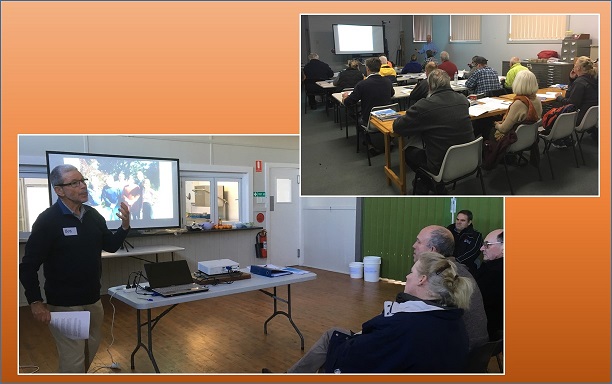
Last month Gunning District Landcare held two events to support the region’s ongoing efforts to control foxes. These were made possible by a grant from the Managing Established Pest Animals and Weeds (MEPAAW) program, funded by NSW DPI and delivered by Landcare NSW.
The first was a 'Fox Baiting Breakfast', on 5th June, organised to thank group leaders and fox baiting participants for their significant ongoing efforts to protect stock and wildlife at a landscape scale. The event also provided an opportunity to hear Bob Spiller give a fascinating presentation on the local history of the Feral Fox Fighter program. Bob outlined some of the early efforts to control foxes in our region, and how foxes contributed to the decline of wildlife, including the local disappearance of the Eastern Stone Curlew. He went on to explain how Jerrawa Creek Landcare’s highly successful Tussock Tamers model was adopted to develop the Feral Fox Fighter program and how substantial work went into publicity and enabling access to free 1080 accreditation training and baits. At this breakfast we also heard from our friendly local LLS Biosecurity staff on the outcomes of the recent round of baiting, and there was an open and wide-ranging discussion with LLS staff about ways to improve the program as we move forward.
The second event was a free 1080/Pindone accreditation training session held on 8th June and conducted by Scott Schlunke, Senior Biosecurity Officer from Yass LLS. This training was very well attended - it was held on a Saturday morning to make it available to people who work off-farm during the week. It was acknowledged again at this training how controlling foxes is the business of all landholders – whether they are large scale sheep or cattle farmers, conservation block owners, hobby farmers, or weekenders. We will to continue to work with LLS and to reach out to all the different types of landholders to ensure we are doing all we can to protect wildlife and stock from foxes in the Gunning region.
A Great Day Fishing
The weather was perfect for Gunning District Landcare’s inaugural redfin fishing competition for kids and teens on Tuesday 23rd April. Fifty-three fishers lined up along Meadow Creek with their rods was a sight to behold. A good number of mums, dads, grandmas and grandads watched on and helped out the younger ones – all the while enjoying the still, warm autumn day. The total haul from the competition was 34 redfin and one enormous carp. Ben Heath of Goulburn took out the prize for the biggest redfin of the day. The same Ben also caught the largest number of redfin in the older age group, closely followed by Gunning keen fisher Ben Gorey. Tom Hinds caught the most redfin in the younger age group, and Angus Mackay got a prize for catching a redfin closest to a ‘mystery’ weight. Two other prizes went to names drawn out of a hat, including 6-year-old twin fishing enthusiasts and a first timer who successfully caught a fish on the day.
Fish expert Mark Lintermans from the University of Canberra weighed and measured all the fish and explained why redfin are so destructive in our local waterways. In short, they are voracious predators of native fish – including the endangered Southern Pygmy Perch which have been found in the Gunning district and are the focus of conservation efforts by Gunning District Landcare. The competition was also a contribution to citizen science; keeping records of the numbers and species of fish caught over a measured time period can help scientists like Mark Lintermans keep track of the ecological health of our creeks and rivers.
Thanks to everyone who participated and made it a great day. A big thank you also goes to those who helped out – including Mark Lintermans, Janet Heffernan, Dan O’Brien, Mardi Lees, Gillian Malcolm, and Scott Keyworth. A special thanks goes to Vanessa and Angus Mackay for starting the conversation about redfin in Meadow Creek, and to the Lions Club of Gunning for putting on yet another great sausage sizzle for the hungry fishers. Vanessa Mackay and Marlene Duus supplied some of the photos above.
Several businesses generously donated prizes for which we are very grateful: Yass Outdoor Sports & Camping, Lilac City Cinema, and BCF Goulburn. Mark Lintermans also donated several copies of his book Wet and Wild.


